This webpage contains information on post Covid-19 fatigue management support
There is a lot of information on fatigue and the factors that can affect it, with strategies to help you manage.
Don’t feel that you have to read this all in one go! You may find it easier to read it in bite sized chunks and use it as a reference to go back to.

What is post-viral fatigue?
Post-viral fatigue is when you have an extended period of feeling unwell and fatigued after a viral infection such as COVID-19. It is not just a feeling of being ‘tired’- it is complex with a range of physical, cognitive, neurological and emotional factors, which may be different from person to person.
Post-viral fatigue is often unpredictable in nature – which can often make resuming previous roles and activities more difficult, thus affecting how we think, how we feel and what we do.
It has been theorised that COVID-19 affects the autonomic nervous system, with a chemical response that is part of the immune response to the acute viral infection.
This can cause loss of energy, fatigue and muscular aches and pains which are normal symptoms of a viral infection.
When this response continues after the acute infection is over fatigue and flu-like symptoms can persist for a prolonged period.
Around 90% of people who contract an acute and prolonged viral infection do recover. However, 10% may not recover, or may take longer to recover, and may go on to develop ‘Post-COVID syndrome’ also known as Long COVID. It is likely that your fatigue is as a result of this ongoing post-COVID syndrome.
Evidence and research on COVID-19 is continuing to evolve. It has been recognised that not all people who are experiencing long-term effects were hospitalised.
From the referrals we have received onto the pathway so far, fatigue is the most common symptom people are experiencing.
Recognising fatigue
Managing your fatigue requires a variety of strategies in order to recognise what the contributing factors may be. Common signs include:
Physical fatigue (Physiological, Neurological)
- Feelings of extreme tiredness or lack of energy
- Inability to complete activities
- Muscle aches and pains
- Reduced appetite
Mental fatigue (Cognitive, Emotional, Social)
- Issues with concentration and memory- ‘brain fog’
- Difficulty with communication
- Mood changes- anxiety/ irritability
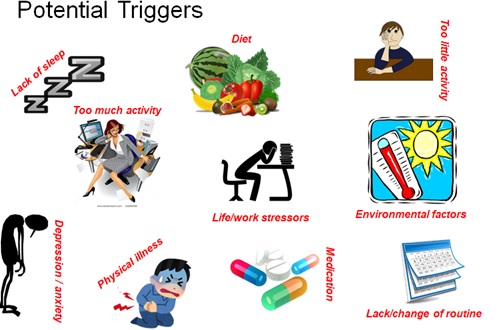
Taking control
This is about understanding the triggers which:
Can be controlled - Those linked to other factors that are not necessarily related to any medical issues, e.g., Disturbed sleep, under/ over activity/ environment.
Can’t be controlled - Those controlled by the body- e.g., Cytokine production, autonomic dysfunction / physical illnesses. Cytokines are small proteins that are crucial in controlling the growth and activity of other immune system cells and blood cells. When released, they signal the immune system to do its job. Cytokines affect the growth of all blood cells and other cells that help the body's immune and inflammation responses
‘The Human Battery’ and activity
- Activity can form a basis of who we are and provide us with a sense of purpose and identity.
- Energy is required to complete all activities, however big or small, and our levels of fatigue will have an impact on what we can/ can’t do. Even minimal activity can lead to prolonged fatigue.
- If we feel like we are fully charged and have lots of energy, it is tempting to do lots and push our limits.
- When the battery is flat, there is no option but to stop and ‘re-charge’ .
- So, ration energy for when it is really needed.
- If some energy is left in the battery, it can be used by your body to build up reserves for use with other activities.
- Recognise that small, every day jobs can have an impact on levels of fatigue - try not to compare to previous lifestyles, instead focus on the ‘here and now.’
- It is important to have an awareness of the variety of factors that can influence your ability to complete an activity.
There are many different types of activity that use up different amounts of energy. It is recommended that people have a balance of activities in order to assist them with pacing and energy conservation.
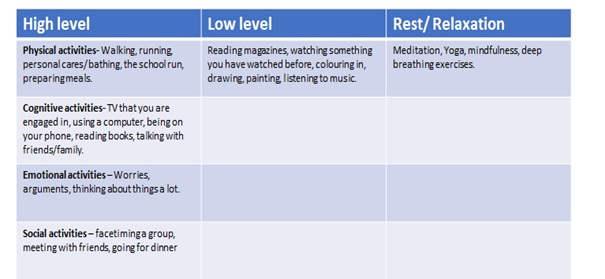
Activity diaries
- The use of activity diaries are a good way to help us recognise the types of activity we carry out each day and how these activities can have an impact on our fatigue levels.
- They allow us to recognise how much we are actually doing, when we may feel that we aren't doing very much.
- They enable us to establish a ‘baseline’ level of functioning- what is a stable and sustainable level.
- They allow us to begin thinking about how we can better plan our activities, how we may pace them and which tasks we may prioritise.
- They help us in being able to identify a ‘just right’ balance between activities that we may NEED to do and those that we WANT to do.
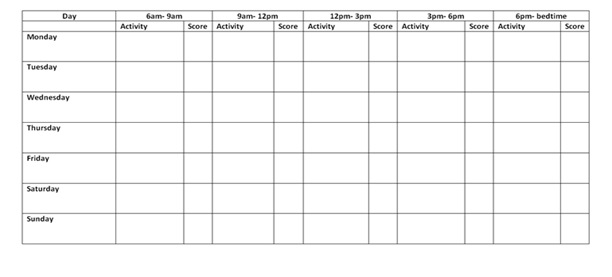
Rating levels of fatigue
0 1 2 3 4 5 6 7 8 9 10
No fatigue Extreme fatigue
- By recognising how an activity makes your feel after completion, it allows you to identify specific patterns.
- A response of 0 would indicate that you do not feel at all fatigued.
- A response of 10 would indicate that you feel totally fatigued and exhausted.
The 3 P’s of good fatigue management – Pacing, planning, and Prioritising
- Pacing - Looking at your diary and identifying how activities be broken up rather than being done all in one go. Finding your baseline level and ensuring that you have a middle ground of not doing too much or too little. Ensuring you incorporate rest periods in between activities to help ‘recharge.’
- Planning - How can you spread activities out throughout the week, can higher energy tasks be carried out at a different time? Think through activities before you do them, could the activity be done differently so it is easier?
- Prioritising - What is necessary and what could wait? What do I WANT to do today/ what do I NEED to do today, Could the task be carried out by somebody else/ could they help?
This helps to avoid the ‘Boom and Bust’ where you have days when you feel good and so increase activity levels, but then the next day feel completely exhausted. Good fatigue management means keeping your activity level at an even level.
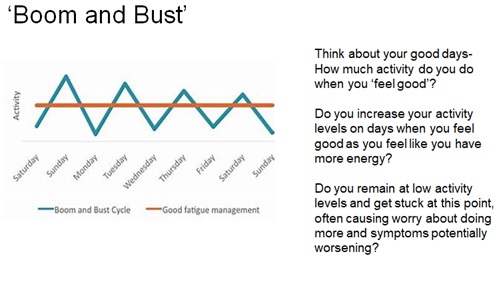
Stable levels of fatigue
- From completing activity diaries, can you notice any patterns? Are your fatigue levels not changing and you feel like you are stuck in the same place?
- Do you have high fatigue levels (8/9) even though you feel you have restricted yourself to low levels of activity?
- The human body needs activity in order to produce energy. Limiting activity can make you exhausted, lethargic and increase pain when you are not moving around as your body isn’t producing as much energy.
- Work through high levels of fatigue very gently- very slowly increasing activity.

Grading activities
- Grading activity is a key concept in the management of fatigue.
- Understanding the different component parts of an activity and how activity can be broken down into achievable steps is the process of grading.
- Grading activity may involve a gradual change in the nature of the activity by changing one or more of the component parts.
- It allows you to look after yourself and gradually increase energy levels, giving you back a sense of control.
- Think of activity grading as a staircase vs a slope – breaking the activity down into achievable steps, and not trying to complete the whole activity in one go.
- Once a job is started, we often want to keep going until it is finished.
- Think about the ‘The Tortoise and the Hare’- rushing to finish the race and crashing with fatigue vs slow and steady, having rests throughout to ensure completion.
Setting your stopping point
- It can often be challenging knowing when to stop.
- People often only stop at the point where they feel they can no longer continue and are experiencing an increase in their symptoms, thus relying on their body to tell them to STOP!
- Imagine you are in a car and the car needs to stop to prevent it from hitting the wall. The brakes need to be applied before the car hits the wall.
Goal setting
- Setting goals allows us to make positive changes to our lifestyle and provides us with something to work towards.
- Setting the right goals is an important first step. Use the SMART technique, setting short- and long-term goals that are:
Specific (you know exactly what you want to achieve); Measurable (you know when you have achieved it); Attainable (not setting yourself up to fail); Relevant (there is a point to the goal); Time based (you know by when you want to have achieved it).
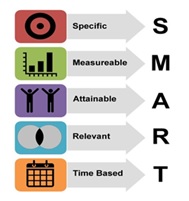
- Being able to achieve our goals and succeed is a great motivator, allowing us to continue to make positive changes.
- By using fatigue diaries and setting yourself small goals, it will allow you to keep on track and reflect on your successes.
Putting it all together!
- We know that fatigue is a common symptom that is affecting people 12+ weeks post COVID infection.
- By understanding fatigue and how it affects you, it will allow you to have better control over your symptoms.
- Recognise triggers and what exacerbates your levels of fatigue. This will allow you to be able to avoid unhealthy habits and better manage your symptoms.
- Avoid ‘flattening the battery’! Ration energy for when it is needed so that you can complete activities you both NEED and also WANT to do.
- Activities, big or small are composed of many skills which use both physical and mental energy.
- Focus on the here and now by understanding what activities you are able to do now, what activities do you have difficulty with, and what activities are more important than others.
- Find a balance of high energy, low energy and rest/relaxation activities in your day in order to assist with pacing and energy conservation.
- An activity diary will allow you to identify any particular patterns in activity, which activities may cause an increase in fatigue levels.
- Planning, pacing and prioritising activities allow you to make changes to your activity in order to maximise the energy you have.
- The human body requires activity in order to produce energy. It is important to have a balance between activity and rest to produce energy and reduce deconditioning.
- Before increasing activity levels, it is important to ensure you have a period of consistency with your activity and fatigue levels.
- By understanding the component parts of an activity, it will allow you to grade an activity to make it more achievable.
- Try not to put too much pressure on yourself to complete a task all in one go - remember the tortoise and the hare! Try to incorporate rest periods to allow you to complete a task and also maintain your energy levels.
- Listen to your body. Don’t crash into that wall and try to stop before the point of exhaustion.
- Set yourself short- and long-term SMART goals - it will allow you to keep on track and reflect on your successes
Exercise and fatigue
What is physical activity and exercise?
- Physical activity is any movement that works your muscles and requires more energy than at rest.
- Exercise is an activity requiring physical effort, carried out to sustain or improve health and fitness.
Why is activity important?
- Covid-19 is a coronavirus.
- A virus will trigger an immune response.
- This immune response can cause inflammation, pain, weakness.
- Initially bed rest and reduced activity levels can aid recovery.
- However, reduced activity can also cause deconditioning, which is where the body becomes weaker.
Remaining in bed can lead to 10-15% loss of muscle mass per week
You may be experiencing the physical effects of fatigue
- Lack of energy
- Breathlessness
- Increased heart rate
- Muscular aches and pains
- Exacerbates tiredness
Pacing
It is important to maintain activity, but equally as important is the pace of the activity so that you do not overdo things, which can lead to ‘Boom and Bust’. Think about:
- What does the exercise/ activity involve?
- Have you completed it before? Have you done more or less?
- If you complete this, will you be able to do the other activities in your day?
- Can you break it up into smaller stages?
- What are my current limitations and if anything, what is stopping me going further/ doing more?
What are the benefits of exercise?
- It improves your mental health through the release of endorphins.
- It can build strength and conditions the muscles and joints.
- It lessens fatigue and can demonstrate progress.
Start thinking about a gradual return to exercise
- What could I do previously?
- What do I know I can do now without triggering fatigue/ other symptoms?
- What do I want to return to?
- Begin with a short, flat walk daily
- Increase the distance/ time gradually – this will vary from person to person
- After you have been for a walk assess how you feel straight after and the day after.
- Aim to build up to 20-30mins – you may start with only two mins or may be 10 mins depends on your level now.
- On a good day only increase your exercise slightly – don’t overdo it.
- Slowly increase the pace of each walk until at a comfortable pace without any post-exertional fatigue.
- Try to build it into your daily routine.
How hard should I work?
The Borg Rating of Perceived Exertion (RPE) scale will help you estimate how hard you’re working (your activity intensity). Perceived exertion is how hard you think your body is exercising. Ratings on this scale are related to heart rate (how hard your heart is working to move blood through your body).
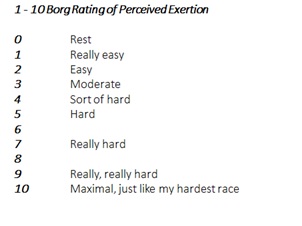
Not all exercise has to be strenuous. Think about other ways to exercise, such as
- Stretches
- Yoga
- Tai Chi
Remember the barriers and….
- Avoid pushing too hard on good days
- Don’t compare yourself to where you were previously
- Don’t focus on the negatives of exercise
- Try to avoid getting anxious
- Balance exercise with other tasks
- Avoid more strenuous exertion or strength exercises e.g. sprints, plank
- Avoid getting too breathlessness
There are some resources to help with monitoring activity levels, such as:
- The step count on your phone
- A Fitbit / smart watch
- Activity diaries
Covid rehab team - fchc.covidrehab@nhs.net
Putting it all together!
- Exercise has many benefits to aid recovery
- Increasing exercise too soon could have a negative impact on fatigue
- It is important to manage return to exercise by pacing
- Avoid pushing too far/ fast too soon to avoid boom/ bust cycle
- Monitor your abilities and set goals based on where you are today
The importance of diet
Your diet is really important, and while you may not think it has a direct impact on fatigue, the two are very closely linked.
Fatigue can lead to…
- Weight changes due to reduced activity – gaining fat without muscle which can then affect your ability to do everyday things.
- Difficulties preparing and shopping for food due to reduced energy levels.
- Cravings for sugary foods and caffeinated drinks to provide energy.
Fatigue can also lead to unintentional weight changes, which in turn can affect fatigue levels.
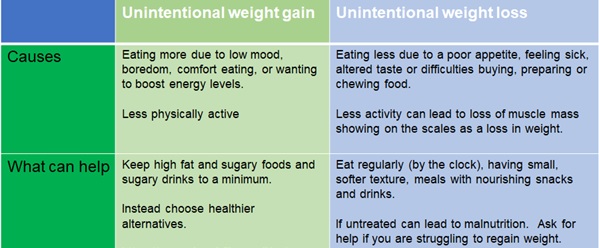
Top tips for eating whilst fatigued
- Little and often: smaller portions, eaten more frequently, can be easier to manage.
- Opt for foods that require minimal preparation.
- Eat when you can, even if this differs from your normal eating pattern.
- Soft, moist foods require less chewing which enables more to be eaten.
- Aiming for a nutritious diet which includes plenty of fruit and vegetables, protein, carbohydrates (wholegrain where possible), and healthy fats can be an important step towards improving your energy levels and minimising muscle loss.
- Drink 6-8 cups of sugar-free and caffeine-free drinks a day.
- Use the Eatwell Guide.
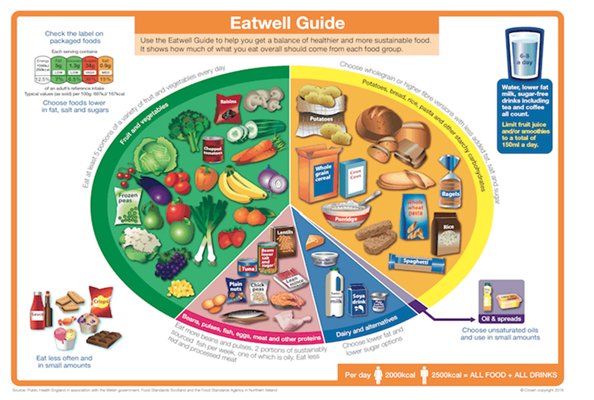
Other important things to think about...
Glycaemic Index
The glycaemic index (GI) is a rating system for foods containing carbohydrates. It shows how quickly each food affects blood sugar (glucose) levels when that food is eaten on its own. Foods that have a low glycaemic index (also known as slow-=release carbs) can help manage energy levels because they have a slower increase in blood glucose levels which help to keep energy levels stable, avoiding large fluctuations.

Is protein important?
- Absolutely!
- Aim to have 2-3 portions of protein per day.
- These include beans, pulses, meat, fish, nuts, vegetarian equivalents, eggs, milk and dairy foods.
- Protein is important for rebuilding muscle mass and strength.
- If you are trying to be more active, make sure you are having enough protein.
Vitamin D
- Is found in oily fish, eggs, meat, milk, margarine and fortified breakfast cereals and yoghurts.
- It helps your body to absorb calcium and keeps your bones, muscles and teeth healthy.
Meal preparation & shopping
- Fatigue can make food shopping, meal preparation and eating more difficult.
- Save energy in the kitchen: use pre prepared or frozen fruits and vegetables, do meal preparation tasks in stages, review kitchen layout to reduce walking.
- Take friends or family up on any offers to help with food shopping or preparation. They can help you prepare healthy, balanced meals to eat or keep in the fridge or freezer for another time.
- Recipe boxes with all the ingredients weighed, chopped and ready prepared may be useful.
- Think about meal and shopping delivery options.
- Utilise ready-made fresh or frozen meals. Wide ranges are available with healthier options and to suit all budgets.
Sugar and caffeine
- It is common to have cravings for sugary foods and caffeine when energy levels are low.
- It may feel initially that sugar or caffeine has helped with energy levels, but this is short lived.
- Consuming too many sugary foods and drinks and too much caffeine, can lead to unwanted dips in energy levels and the person can often feel worse than before.
- Eating regularly and having a healthy diet helps minimise cravings,
- Try having a healthy alternative on standby when cravings hit e.g. diet caffeine-free soft drink, fruit, dark chocolate, nuts, homemade popcorn,
Putting it altogether!
- Follow a healthy, well-balanced diet
- Include protein and vitamin D in your diet
- Think about low GI foods
- Stay well hydrated
- Drink alcohol with care
- Moderate ‘treat’ foods
Sleep hygiene, stress and relaxation
Poor sleep or erratic sleep routines can add a significant layer of fatigue.
Therefore, managing your sleep patterns can play a helpful role in managing your fatigue.
Consequences of sleeping too much may be:
- The increased need for more sleep i.e., a vicious circle.
- Inability to concentrate properly.
- Loss of motivation and energy whilst awake.
- Reduced enjoyment and satisfaction in life.
- Sleeping during the day may detract from the quality of night-time sleep.
Consequences of sleeping too little may be:
- Feeling un-refreshed on waking.
- Reduced ability to think clearly or concentrate.
- More susceptible to erratic emotions/tearfulness/irritability.
- Feeling less resilient to cope with life events.
- Feeling irritable, short tempered.
- Physical symptoms of the body aching, limbs feeling heavy and muscles tired.
Helpful tips to get a restful sleep
- Completing a sleep diary.
- Set a regular waking time (set alarm clock) and get up at this time every day.
- Establish a helpful night-time routine.
- Do not worry about getting to sleep.
- To settle your mind, keep a notebook and pen by your bed to ‘empty’ your thoughts onto.
- Problem solve anything which is waking you up in the night e.g. (needing the toilet, pain, discomfort, breathlessness). Think about reducing fluid two hours before, pain management, different positions to reduce discomfort, have any breathlessness investigated.
- Save the bedroom for sleep and sex.
- Exercise.
influences on your sleep?
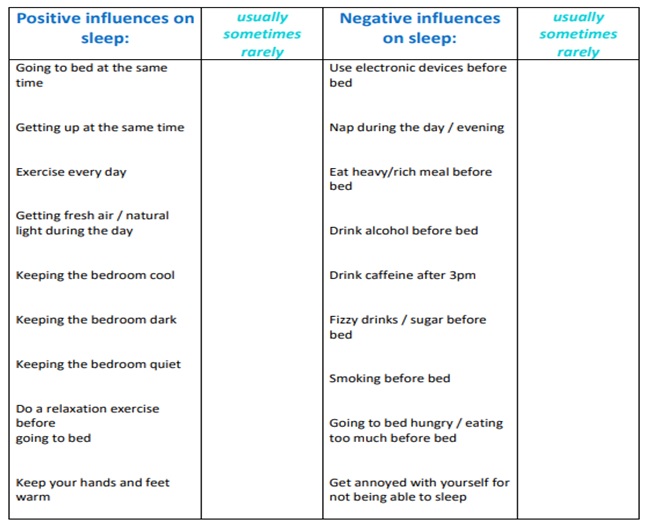
Relaxation and sleep
- Some people can have trouble with getting a restful sleep as their minds and thoughts can be racing prior to bed or wake them in the night.
- Relaxation prior to bed may be an effective technique to help calm the mind and get ready for a restful sleep.
- Headspace, Insight Timer, Calm app, and other mediation apps have ‘sleep’ sections that have guided meditations to bring your body into a parasympathetic state (rest).
Stress, anxiety and fatigue
- Not being able to do what we could previously or knowing what our bodies are capable of doing can leave us feeling under pressure, stressed and frustrated at ourselves and others.
- Stress, anger, frustration, anxiety are all draining emotions. Our body demands a lot of energy to feel these emotions and this can be a contributing factor to your physical fatigue.
- The cycle below shows this negative cycle that needs to be broken to assist with managing stress and fatigue.
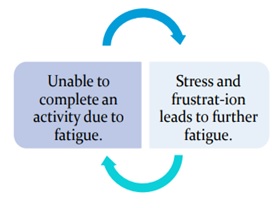
‘Flight or fight mode’
Our bodies have this internal ‘flight’ or ‘fight’ mode and can fire up when experiencing stress while recovering from a post viral infection. The fight or flight response is an automatic physiological reaction to an event that is perceived as stressful or frightening. The perception of threat activates the sympathetic nervous system and triggers an acute stress response that prepares the body to fight or flee.
This can be felt as:
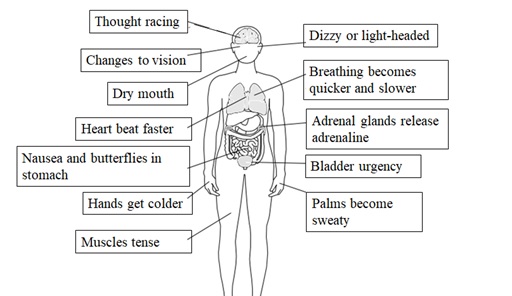
Emotional signs of stress
When we have too much going on or something in particular is causing stress these are the sorts of emotions we see. Maybe you can all pick out at least one emotion in there you may feel when stressed.
- Angry, irritable and wound up
- Anxious and full of dread
- Unhappy, upset and tearful
- Lacking in interest
- Overwhelmed and frustrated
- Guilty and worthless
How to manage stress levels
- Ensure your days and weeks are balanced- work, rest and play.
- Learn relaxation strategies which work for you and put them into regular practice.
- Talk to others and gain support; includes family, friends, work colleagues or managers.
- Use your 3 P’s (Pace, Prioritise and Plan) to make sure you plan pleasurable activities.
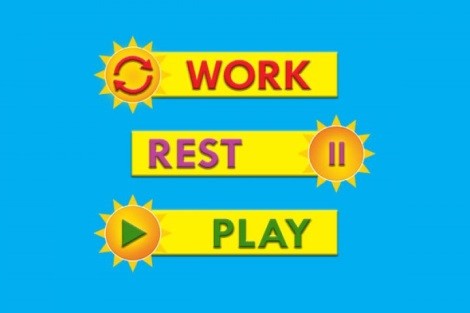
Negative thoughts
- During your recovery, you will have good and bad days.
- This is normal and it is important not to dwell on the negative.
- Try to be kind to yourself.
- Try to think about what advice you would give to your friends rather than being too critical on yourself.
If you are finding it hard to overcome negative thoughts, please speak to your therapist for advice.
Relaxation
Relaxation is the process that decreases the effect of stress on the mind and body. Benefits of relaxation are that it:
- Lowers heart rate and blood pressure
- Slows breathing rate
- Increase blood flow to major muscles
- Reduces muscle tensions and pain
- Reduces anger and frustration, boosts confidence and mood
- Improves sleep
- Reduces the activity of stress hormones
Types of relaxation:
- Progressive muscle relaxation
- Visualisations
- Deep breathing/ abdominal breathing
- Massage/ reflexology
- Tai Chi/ Yoga
- Aromatherapy
- Meditation
- Mindfulness
Where to find relaxation techniques to try
- YouTube/ Google
- Specialised community yoga/ Tai Chi studios/ teachers
- Mindfulness can be done when going for a walk in nature
- Apps (applications for smart phones, some have some free access but for further types of relaxation may be a fee per month or year)
- Headspace (also on Netflix)
- Calm
- Insight Timer
Putting it all together!
- Managing your sleep patterns can play a helpful role in managing your fatigue.
- Relaxation prior to bed may be an effective technique to help calm the mind and get ready for a restful sleep.
- Stress, anger, frustration, anxiety are all draining emotions that can worsen fatigue.
- Ensure your days and weeks are balanced- work, rest and play.
- Learn relaxation strategies which work for you and practice them regularly
Cognition and fatigue
As well as physical fatigue we can also experience mental fatigue or ‘brain fog’ which can show as:
- Poor memory
- Reduced attention or concentration
- Communication difficulties
Like physical fatigue, mental fatigue can reduce our ability to perform daily tasks - work related tasks, managing money, reading, remembering a shopping list, speaking on the phone, etc.
Understanding memory
Our memory is a bit like a filing cabinet that works in three stages:
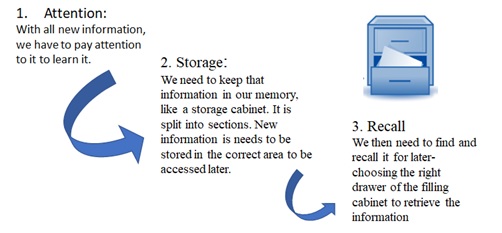
Types of memory
There are three different types of memory:
- Working Memory - Lasts for seconds, allows us to hold information for short period of time (e.g., reading a phone number and dialling it)
- Short Term Memory - Remembering information given to us in the last few hours, days or weeks (e.g., remembering conversation from last week)
- Long Term Memory - Allows us to remember things from a long time ago. These memories are usually easier to remember as they have been used for several times and have more meaning to us. (e.g., remembering a family holiday, how to make a cup of tea)
Common memory problems
- Forgetting where you have put things
- Forgetting phone messages
- Forgetting directions or getting lost
- Losing items or forgetting where things belong
- Forgetting what people tell you
- Forgetting what you need to do
- Going off on tangents when having a conversation
Strategies to support memory
Internal strategies
- Making associations
- Chunking (group like items together in your mind, make associations between things).
- Making mental pictures
- Repetition
- ‘Memory Palace’ (associate things with a particular place, and imagine yourself walking through that place)
- Mnemonics (using the first letter of each word in a sentence).
- Rhymes
- Acronyms
- Create stories
The strategies that will work the best, are the ones that are more meaningful to you!
External strategies
- Diaries
- Journals
- Calendars
- Whiteboards/ blackboards
- Phone alarms/ Alexa or Google home devices
- Labels and post it notes
- Organisational systems
- Organise your home
We recommend a combination of strategies may be useful for your day-to-day activities.
Understanding attention
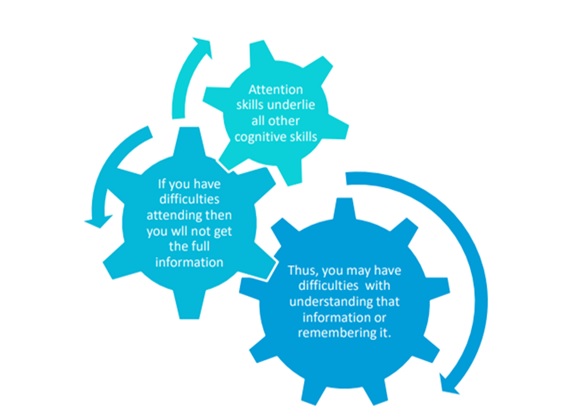
There are different types of attention:
Selective
- Filtering out all the background distractions to focus on something specific, e.g., listening to a conversation in a busy café
Sustained
- Concentrating for prolonged periods of time on the same thing, e.g. reading a book
Divided
- Being able to pay attention to two or more things at the same time, e.g. driving and holding a conversation
How to improve attention?
- Focus on tasks for a short time, don’t overdo it.
- Shut out distractions- turn off phone, TV, radio.
- Have a balance of activity in the day- work, rest and enjoyable activities.
- Take regular breaks.
- Try and decrease stress/ worry/ tension. Try to empty your mind to give the task your full attention.
- Take time out from others if it’s overwhelming.
- Start small and for a short time (e.g. returning to reading)’
- Prep and plan- organise your environment.
- Complete when you’re less fatigued’
- Just like when we are physically fatigued, we need to be doing the 3 P’s (Pace, Priorities, Plan) for our brains as well!
Understanding communication
Communication is another thinking skill that we all use day to day.
Just like our memory and attention, the way we communicate can be impacted by our fatigue levels. Common issues due to fatigue are:
- Slow to process what other people are saying.
- Word finding: having difficulty finding the right word to use.
- Selecting the right topic: not making sense in conversation.
- Difficulty reading/ writing and understanding the information.
- Slower talking: not getting your words out as quickly as normal.
- Putting words together in a clear message.
Strategies to improve communication
- Do not rush, take your time and slow down.
- Take control:
- Let people know you’ve had COVID and how it has affected you.
- Let people know you’re feeling tired and may need to cut phone call/ conversation short but will talk when feeling more energetic.
- Time interactions for when you’re at your best.
- Attention and memory strategies to help with understanding information coming in.
- Describe what it is your trying to say to help people understand the word your looking for.
- Think of an alternative word.
- Write it down.
- Use predictive text apps on phone/ computer.
Putting it all together!
- Use a range of strategies to help with your memory.
- Keep conversations and tasks short so that you can maintain focus and attention.
- Be open with others if you are having difficulty.
- Take your time.
- Take regular breaks.
- Relax and regulate stress levels.
Effects of Post-COVID fatigue on work
This can be in the form of:
- Difficulties in cognitive processing (attention, memory, information processing speed, complex tasks/multitasking).
- Sensory overwhelm in the work environment (noise, social interaction).
- Expectations of colleagues/boss, and the work/ office culture.
Legislation
This can be in the form of:
- Difficulties in cognitive processing (attention, memory, information processing speed, complex tasks/multitasking).
- Sensory overwhelm in the work environment (noise, social interaction).
- Expectations of colleagues/boss, and the work/ office culture.
Legislation
The Equality Act (Department of Health, 2010) gives workers’ rights of employment
- It is Unlawful to discriminate in all aspect of employment – in recruitment, selection, training and redundancy.
- Anyone can ask their employer for reasonable adjustment to do their job (so job is no harder to do than for a non-disabled person).
- Everyone has the Right to confidentiality.
Disclosure
Benefits of disclosure:
- Legally protected against discrimination.
- Sense of control: Proactive not reactive.
- Timely access to support.
If you do disclose at work, then:
- Don't rush
- Location
- Second person
- Be prepared
- Identify the most appropriate person
- Disclose to OH doesn’t mean disclosure to manager/colleagues
- Keep a written record of discussions
Examples of “reasonable adjustments” that can be made to ease your ability to do your job
- Alter premises
- Alter working hours
- Acquire or modify equipment
- Alter role/ responsibilities
- Additional support
- Allow for absences (rehab or treatment)
- Adjustments should be flexible, reviewed and modified.
Other options
- Do something different
- Consider sick leave policies
- Look for disability friendly employers
- Voluntary opportunities
Resources/online support
https://www.yourcovidrecovery.nhs.uk/your-road-to-recovery/returning-to…
Disability Law Service: http://dls.org.uk
https://www.mind.org.uk/workplace/coronavirus-and-work/
https://www.cipd.co.uk/knowledge/fundamentals/emp-law/employees/workpla…#gref
First Community provides front-line NHS community healthcare services in east Surrey and parts of West Sussex.
We provide first-rate care, through our first-rate people, offering first-rate value. For more information visit: www.firstcommunityhealthcare.co.uk
If you would like this information in another format, for example large print or easy read, or if you need help communicating with us:
First Community (Head Office)
Call: 01737 775450 Email: fchc.enquiries@nhs.net Text: 07814 639034
Address: First Community Health and Care, Orchard House, Unit 8a, Orchard Business Centre, Bonehurst Road, Redhill RH1 5EL
- Twitter: @1stchatter
- Facebook: @firstcommunityhcNHS
- Instagram: firstcommunityhealthandcare
- LinkedIn: www.linkedin.com/company/first-community-health-&-care-c-i-c-/
- TikTok: www.tiktok.com/discover/first-community-health-and-care
To print this page, please select accessibility tools and the print this page icon.
For office use: Version COVID-049 Post Covid-19 Fatigue Management v1 . Review Date: September 2022


